COVID-19 is still raging outside in the world, so I’m continuing on my attempt at avoiding writing about it in this newsletter.
Instead, this week, we’re going to look at a very simple thing:
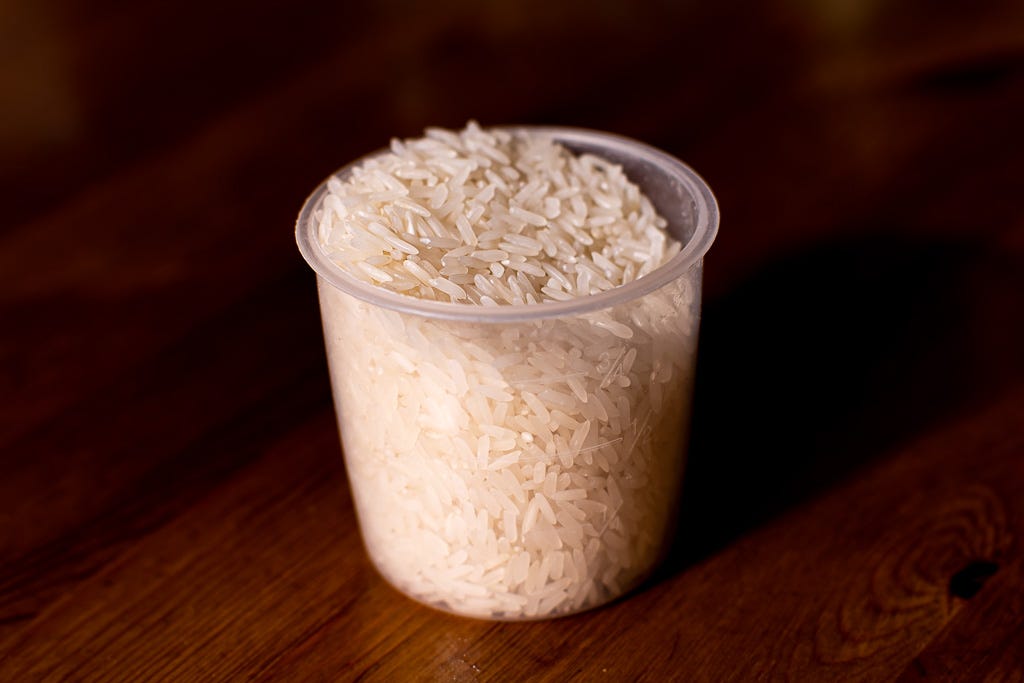
This is a measuring cup that comes with a rice cooker. It holds 180mL worth of rice. Mine is from a Japanese brand rice cooker sold in the US market, but I know this size cup is also used in Chinese ones. As far as I can find out, it’s the de-facto standard for rice cooker measurement (actual recipes may differ in the ‘cup’ used).
180mL has apparently no relation to any cup size outside of Japan. In the US, a customary cup is ~236mL, a legal cup for nutrition labels is 240mL. Metric cups in certain Commonwealth Nations are 250mL, and there’s other various customary “cups” around the world but nothing near 180mL. (Wiki)
This 180mL volume is the Japanese Gō (合). In 2020, it’s primarily used to measure just two things: rice and sake. But it’s a unit that has a long history to it, and looking at the history of units of measurement is fun because units are inevitably bound with civilization, trade, and science.
Apologies ahead of time that some of the references and links I’ve been using are in Japanese because the information content between different language wikipedia pages can differ significantly.
Way Back in Ancient Times
As with many very old things in Japan, the system for of weights and measures can trace its roots back to ancient China. This isn’t surprising since China was the major geopolitical power in the region for millennia and nearby civilizations would integrate various parts of Chinese culture into their own. Weights and measures would have been especially important for trade purposes.
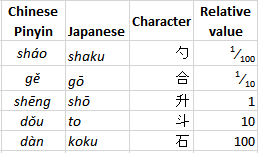
Above is a list of the traditional units of volume in both Chinese and Japanese. They actually use the exact same Han character to represent them, but the pronunciations had diverged due to sound change (note how dǒu and to sound very similar).
The key takeaway here is that this system of measures is set on a decimal system much like the metric system. One unit is 10 or 1/10th of another unit. What makes it differ from metric is how the base unit (typically the 升) is defined.
The standard of reference for volume in China was a large bronze vessel, the Jialiang, which seem to date to the Xin dynasty in 9-23 CE, a brief dynasty within the longer Western Han and Eastern Han dynasties.
The first reference to the Japanese 升 (100合) dates to 701 CE in the Taiho ritsuryo (The Taiho Code), which officially adopted a system of government based on the Tang dynasty’s (618 CE-907 CE) system, meaning they imported an version of the Tang era 升 (the wiki states a large 升 was estimated to be 0.71L (40% of the modern value). The exact size was estimated by Japanese Edo-period scholars centuries after its adoption, but it seems to agree with period warehouse sizes.
What’s interesting about this whole mess is that while the system of measurement itself may have traced its roots back to the Han dynasty, the actual measurements even within China shifted quite dramatically over time.
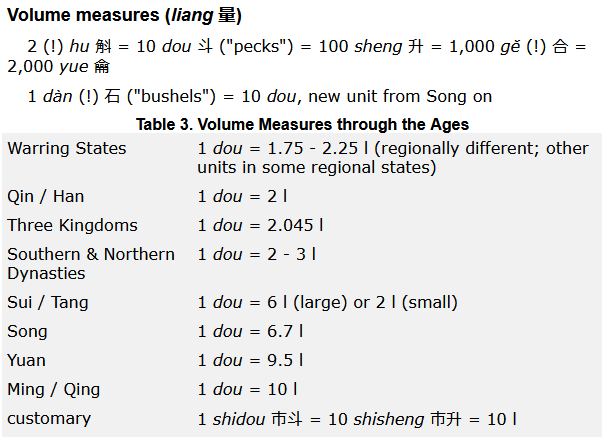
Volume measurements over time in China
Note that the historical values quoted above are too round and are obviously approximations. It’s highly unlikely that an archaeological reconstruction of measurements from 2000 years ago were spot on exactly equal to round metric values. Even if we had artifacts from the period, the natural wear and tear of materials over millennia would throw those measurements off.
Since a modern Japanese 合 is 180mL, a single 斗 would constitute 18L of volume, which is almost double even the highest historic measure for the unit in China on the table above. It’s obvious that over time, the standard of volume had shifted within Japan.
Defining Volume
Before we go further down the timeline, we should take a break to consider how volume measurements are defined and transmitted.
For example, take the liter. To my surprise, it is NOT the official SI unit of volume (that distinction goes to the cubic meter) but is accepted for use within the SI system (goes to show how bad my metric knowledge is). It’s defined as the volume of a cube 10cm x 10cm x 10cm (so 1/1000th of a cubic meter). Notice that this definition relies on a length measurement, so that anyone with a properly calibrated ruler could construct a container that holds a liter.
So this gives 2 sources of potential change. One is the definition of length. If the meter were somehow redefined to a different length and the liter definition left unchanged, the volume contained by the liter would change. Similarly, the definition of the liter could change if the measurements of the containers were redefined (to say, 5cm x 5cm x 5cm).
This is relevant when considering ancient measurements because people writing very often assume that the measure they’re using is obvious. An inch is obviously “an inch”, right? Even though historically the length of an inch varied since thumbs vary. So unless you can pin down exactly what units the writer had in mind when describing a unit, it’s very easy to come up with incorrect values.
For the 合 unit we’re interested in today, the traditional container definition was the masu, which you may recognize as the plain wooden box that sake is sometimes served in.
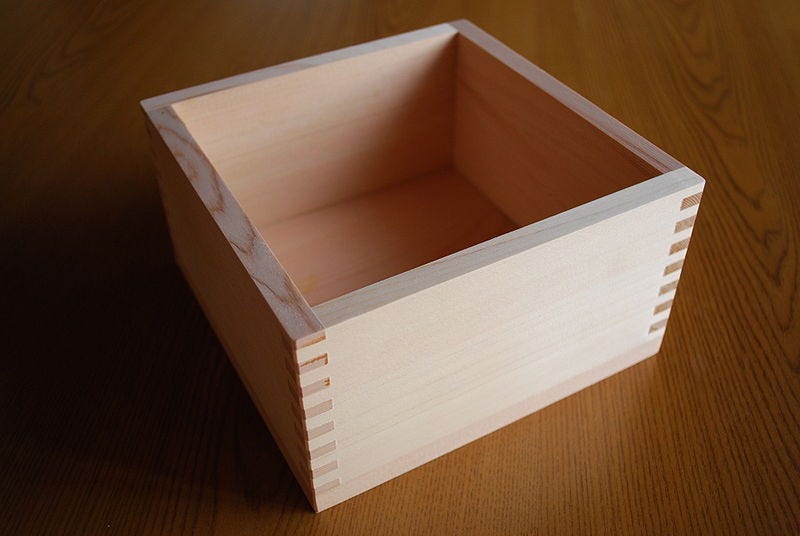
A masu, from the wikpedia page, source
Feudal Japan
As stated above, the official adoption of the Chinese Tang Dynasty’s system of government and measures by the Japan government came around 701 CE, which would place it within the Asuka period of Japanese history, which is considered part of their Classical era. The classical period also sees the Japanese adopt other aspects of Chinese culture, such as the writing system, Buddhism, and Confucianism.
The history of the unit of measure then falls into apparent disarray over the course of many centuries as the socio-political situation change. Power shifts from the central imperial court to regional lords and the country devolves into constant warring during the Medieval period.
Different regions start using their own local versions of measures. The JP wiki for this period mentions that literary sources show some evidence that the units may have been 62.7%, 82.2%, and 49.32% of the modern value, but there’s inconclusive evidence of a widely used value. Obviously the local measures made inter-regional trade more complicated, which led to pressure to standardize on a measurement as warlords started conquering various regions.
When Oda Nobunaga began and Toyotomi Hideyoshi completed the unification of Japan in the 1580s, power once again became centralized again. The masu that represented 10合 = 1升 that been used around Kyoto (the location of the imperial court) at the time became the standard and was called the “[Old] Kyo-masu” (lit. “capital’s masu”, “old” was later added to distinguish from a newer one later). The definition of that masu box comes out to a volume of 1.74L, approximate 96.4% of the modern value.
This unit of measure would then form the basis of Toyotomi’s “Kokudaka” system of taxation. After a large survey, land would be assigned an expected yield of rice, the kokudaka. As mentioned earlier, one koku, approximately 1000 servings of rice, was considered enough to feed one person for a year. Land was classified by its kokudaka which indirectly indicated how large a population (and how large an army) that land could support.
Thus, the lands with the largest kokudaka would be given as spoils of war, often to the shogun’s favored daimyo and allies. But, given political realities of the wartime alliances involved, strong rivals (like the Tokugawa clan) were also given significant lands, but farther away from the capital. The 1598 survey after unification assessed the entire country as having 18.5M koku, of which 2 million were controlled by Toyotomi, while Tokugawa held 2.5 million.
Incidentally, non-rice crops were given a rice-equivalent value and yield and taxation followed the normal rules. Thus, rice was a form of currency for tax purposes even though coins and money were used in normal trade. In the Edo period that came soon after, regional taxes were literally paid by delivering rice.
Since the land surveys and tax assessments were done fairly infrequently (every year or every five years), as time went on, local rulers were strongly incentivized to increase crop yields, since their tax base didn’t grow with the increase in yield. In 1650, merely 52 years later, Japan had an assesed kokudaka of 26 million koku (+40%) (src).
Finally, a bit over a decade after the Toyotomi unifies Japan, more death, fighting, and politics happen, and Tokugawa Ieyasu takes control and founds the Tokugawa Shogunate that would last over 300 years until the Meiji restoration. He also moved the capital from Kyoto to Tokyo (called Edo at the time), thus the period was called the Edo period.
It is during this Edo-period that the Kyo-masu that defines the 升 we’ve been tracing through the centuries sees a final revision in 1669 CE, with the “New Kyo-masu”.
The change was subtle and possibly a mathematical mistake, the Old Kyo-masu was a square box with sides 5寸 and depth of 2.5寸 (one 寸 [sun] in modern times is defined as 1/33 meters, 30.303mm. It was likely similar in historical usage as the inch, roughly the first joint of a thumb).
The New Kyo-masu was defined as a square box with sides 4.9寸 and depth of 2.7寸. That may have seemed like a neutral change to administrators at the time—take 0.1寸 from each side, add that difference of 0.2寸 to the depth— but it increased the volume about 3.7%, to 1.8039L.
Oops.
Either way, this redefined Kyo-masu would remain the standard for about 300 years until the end of the Tokugawa Shogunate with the Meiji Restoration.
We’re almost at the end of this journey folks!
Meiji Restoration and Adopting Metric
The Tokugawa Shogunate represented a period of isolationism for Japan, with practically no contact with foreign nations outside of a few ports the entire time. That isolation was famously ended when US Commodore Matthew Perry forcibly opened more ports of trade with Japan during his expedition in 1853-1855, thus leading to the breaking of the policy of isolationism.
The show of force left an impression upon the Japanese that they were behind technologically. Soon afterwards, myriad factors at the time led to the revolution that overthrew the 300+ year old feudal government and would be called Meiji Restoration in 1868.
The Japanese then well all-in on industrialization and modernization. Lifting a 250 year ban on Japanese natives leaving the country, an huge amount of knowledge and culture flowed back and forth. German-Japan relations were especially strong during this period, bringing many Germanic loanwords into the Japanese language, as well as setting the stage for the Second World War.
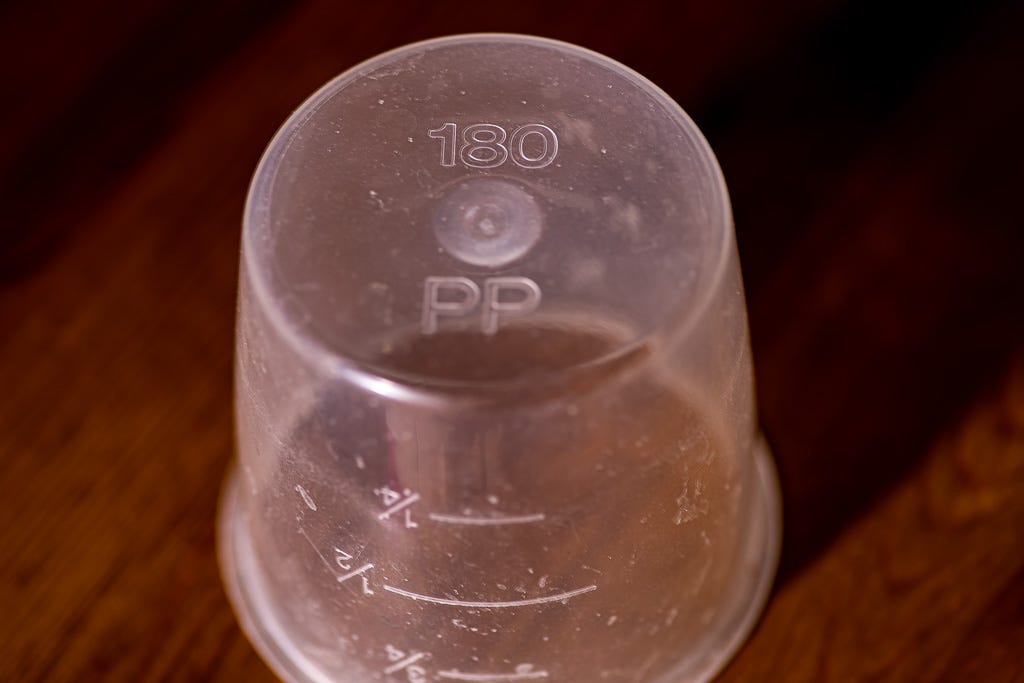
So my measuring cup clearly says 180 on it, referring to 180mL. It’s also PolyPropelene.
During the Meiji period, Japan signs the Treaty of the Meter in 1885, taking effect in 1886. However, they didn’t receive their prototype meter and kilogram until 1890, and it took until 1891 for the 升 to be officially defined as 2401/1331 liters, ~1.804L. I assume this was because without an official reference meter, they were unable to properly calibrate measurement tools to define the exact conversion factor. From there, the 合 is 1/10th of that which brings us to the 180mL figure we have today.
Side note, the International Prototype Meter bars were created in 1889, with Japan receiving bar No. 22. The US received bars 21 and 27. Official publication in French, see pg. 40. The meter has since been redefined to be based on specific properties light in 1960, then again in 1983.
Finally, the use of the Shakkanhou (the name for the traditional system of measures) as an official measuring system was legally banned in Dec 31, 1958. Starting in 1960, metric was the official legal measuring system, but non-metric units are occasionally used in various places like carpentry.
What about China?
The Chinese traditional units had followed a similar pattern of degradation in China as socio-political systems waxed and waned. It eventually led to chaos where “by 1936 official investigations uncovered 53 values for the chi varying from 200 millimetres to 1250 millimetres; 32 values of the cheng, between 500 millilitres and 8 litres; and 36 different tsin ranging from 300 grams to 2500 grams.“(src)
In 1930, the Nationalist government declared that the Chinese 合 (ge) would be 100mL, which the PRC would reaffirm in 1959, but renamed to 分升 (fensheng, fraction of a 升). With China having gone full metric, they will use 升 to refer to a liter in daily usage, but rarely use 分升.
And we’re done!
There you have it, a journey across time and culture spanning almost 2000 years, all because I was hungry during a pandemic.
This probably doesn’t matter too much in your day-to-day life, but I hope it was an interesting read for you. I personally find that appreciating the complexity that goes behind something as simple as a volume measurement helps me deal with the fact that the metrics I set in professional life often trace similar arcs of definition, redefinition, and chaos. No metric is perfect, not even something we take for granted like the meter, or a “cup” of rice.
Take care out there. Hope have a good meal tonight.
Fun links I found along the way I don’t quite know what to do with:
A seller of wodden masu boxes, lots of them.
Another masu manufacturer, what’s interesting is that the internal dimensions are not exactly the same, so long as the volume comes out the same.



